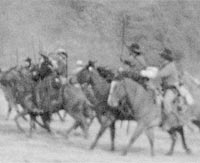The Battle of Westport pitted Confederate General Sterling Price against Union General Samuel Curtis in the largest Civil War battle fought west of the Mississippi River. General Price had begun the invasion of Missouri in September 1864 and intended it to force the Union to send more troops to the Western theatre, thereby relieving pressure on the Confederate armies in the East and weakening Northern political solidarity. Price’s raids at Pilot Knob in the eastern part of the state and Jefferson City in the central part of the state were repulsed by strong Union resistance, so he set his sights on Fort Leavenworth in northeast Kansas.
General Curtis’s Union forces formed a defensive line at the Blue River on October 21, 1864, to stop Price’s westward march toward Leavenworth. On October 22, Price’s army of 9,000 crossed the Blue River at Byram’s Ford near present-day Swope Park, forcing the Union garrison to retreat to the northwest. Curtis set up a new defensive line along the south side of Brush Creek, just south of Westport. Better fortunes arrived later that day as a Union cavalry division led by General Alfred Pleasonton arrived from the East, bringing the Union forces to more than 20,000 soldiers.
The Battle of Westport culminated the next day as Price’s army pushed Curtis’s troops north across Brush Creek to the location of the present-day Country Club Plaza. The brief Confederate advance ended, however, as Pleasonton’s cavalry pressured the Confederates from the east at Byram’s Ford, and Curtis led a counterattack back south across Brush Creek. Price’s army retreated across present-day Loose Park. An outdoor exhibit on the south end of Loose Park interprets the battle in greater detail.
Each side lost about 1,500 soldiers that day, but the battle took a greater toll on the smaller Confederate army, which was forced to retreat southward. Pleasonton’s pursuing cavalry then overtook Price’s army at Mine Creek in Linn County, Kansas, on October 25. This time the Union forces were outnumbered two-to-one, but a swift cavalry attack while the Confederates crossed Mine Creek brought another victory for the Union. In one of the largest mounted cavalry battles of the war and the only major battle fought in Kansas, Price’s army lost another 1,200 soldiers who were injured, captured, or killed. After the Battle of Mine Creek, Price’s beaten army of about 6,000 retreated to Arkansas, where it dispersed in early November.
Even though the Battle of Westport has been called the “Gettysburg of the West,” it is not remembered as a major turning point in the war. Instead, it was an indication of the war’s looming end. Price’s raid was the last major Confederate offensive into Northern territory, and his defeat at Westport solidified Union dominance in the West.
View images relating to the Battle of Westport from the Missouri Valley Special Collections:
- Painting of Sterling Price.
- Photograph of Sterling Price.
- Battle of Westport Drawing.
- Battle of Westport Map.
- Another Battle of Westport Map.
- Battle of Westport Memorial.
- Battle of Westport Re-enactment, 1989.
- Harris House Hotel; General Curtis’s headquarters at Westport.
Check out the following books about the Battle of Westport and the Civil War in Kansas and Missouri:
- Action Before Westport, 1864, by Howard Monnett; widely considered the standard historical account of the Battle of Westport.
- The Battle of Westport, by Paul B. Jenkins; one of the earliest books written about the battle.
- Gettysburg of the West: The Battle of Westport, October 21-23, 1864, by Fred L. Lee; contains a full narrative history plus helpful images and maps.
- They Deserved a Better Fate: The Second Kansas State Militia and the Price Raid, 1864, by Roy Dean Bird; offers an account of the Second Kansas State Militia, one of the Union divisions engaged at the Battle of Westport.
- The Last Long Mile: Westport to Arkansas, October 1864, by Carolyn M. Bartels; a history of the aftermath of Price’s defeat at Westport.
- Civil War on the Western Border, 1854-1865, by Jay Monaghan; includes a brief chapter on the Battle of Westport, pp. 329-336.
- Civil War on the Missouri-Kansas Border, by Donald L. Gilmore; focuses on guerilla warfare and American Indian involvement in Kansas and Missouri.
Check out the following video about the 1989 reenactment of the Battle of Westport:
Follow the Battle of Westport self-guided tour created by the Monnett Battle of Westport Fund.
Continue your own research on the Civil War near Kansas City using the following archival resources from the Missouri Valley Special Collections.
- Various articles about the Battle of Westport
- Vertical File: Civil War--Kansas--Battle of Mine Creek
- Copy of a handwritten letter by Reverend Jonathan Fuller in the aftermath of the Battle of Westport
- Information about Turner Gill, mayor of Kansas City and a Confederate captain in the Battle of Westport
- Vertical File: Civil War--Missouri--Battle of Pilot Knob
References:
Rick Montgomery & Shirl Kasper, Kansas City: An American Story (Kansas City, MO: Kansas City Star Books, 1999), 54-56.
Sherry Lamb Schirmer & Richard D. McKinzie, At the River’s Bend: an Illustrated History of Kansas City, Independence and Jackson County (Marceline, MO: Walsworth Publishing, 1982), 39.
Howard N. Monnett, Action Before Westport, 1864 (Kansas City, Mo: Westport Historical Society, 1964), 21-24, 26-28, 79-80, 85-86, 95-96, 111-117, 128-138.
Donald L. Gilmore, Civil War on the Missouri-Kansas Border (Gretna, LA: Pelican, 2006), 286-289.



